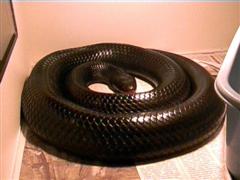Indigo - eastern
Blue Bull Snake, Couper's Snake, American Corais Snake, Georgia Snake, Blue Gopher Snake Scientific Name: Drymarchon corias couperi
Sat, 21st June, 2025 - 4:06 pm GMT
Sponsor Ads:

Alternative Name
Blue Bull Snake, Couper's Snake, American Corais Snake, Georgia Snake, Blue Gopher Snake Scientific Name: Drymarchon corias couperiBasic Info
The average Eastern Indigo will reach a maximum length 6 to 8 feet at maturity, though individuals as large as 9 feet have been documented. Most Eastern Indigos appear to be black snakes, though in the light their scales are very dark blue, which may account for their common name. They also have small amounts of coloration on the sides of their heads and on their chin. These markings are usually red or cream. Some may also have red on their bellies. Some individuals may also have browner coloration than others throughout. They are strong snakes that have heavy bodies.
Health
Adult Eastern Indigo snake should be housed in a large terrarium. One side of the tank should have a hide box and they other should have a warmer basking area. Hide boxes are important as this species spends much of its time in hiding. A large water dish should be placed in the tank, and it serves a dual purpose. Water will provide a good soaking spot as well as increase humidity in the enclosure. Eastern Indigos are diurnal snakes and should therefore be fed in the daytime. They have fairly fast metabolisms and should be fed frequently. Once a week is usually sufficient. Breeding The Eastern Indigo is bred regularly in captivity. They usually breed in the fall or winter, and as with all colubrids, they are egg layers. The eggs should be incubated at 78 to 80 degrees Fahrenheit and should hatch in approximately 90 days. Hatching occurs approximately 200 days after the snakes have bred. Breeding ease is reported by some keepers to be easier and more difficult than many colubrid species by other keepers. This seems to be related to proper diet, care, and housing. Specimens without the proper conditions are less likely to successfully breed. Most people have found them to be more difficult to breed than other colubrids. Before breeding it is important that they have been well fed and have good body weight. When attempting to breed these snakes the enclosure should be cooled slightly to simulate the onset of fall/winter.Habitat
N/ABehavior
The Eastern Indigo Snake is the longest non-venomous snake (and the largest colubrid) in North America. Despite their large size, they are a relatively non-aggressive snake and are therefore quite popular in the pet trade. The Eastern Indigo Snake is usually a very docile snake and some people refer to them as Lap Snakes" since many of them seem very content to just lie where they are put. With frequent handling this snake seems to tolerate people quite well. Most Indigos rarely bite, though some may bite if they associate their handlers with food. It should be noted, however, that there are always exceptions and some individuals may be more nervous than others. In addition to their docile temperament this snake is also quite popular due to their large size. Many hobbyists report that the Eastern Indigo exhibits a curiosity and awareness of their surroundings, which is uncommon in reptiles. Because of their large size, however, they may not be suitable for every hobbyist. Adult specimens will require large cages with plenty of space to move around.Origin
United StatesHistory
Eastern Indigo Snakes have been known by a number of different common names including Indigo Snake, Blue Bull Snake, Couper's Snake, American Corais Snake, Georgia Snake and the Blue Gopher Snake. This snake is commonly seen in the Southeastern United States including Southeastern South Carolina, Alabama, Georgia, Southern Mississippi and Florida. It may sometimes be confused with the Texas Indigo Snake (corais erebennus). The Eastern Indigo is currently threatened in its most of its natural range, though laws have been enacted in most areas to help protect them. Some areas within the United States require permits in order to keep them in captivity. In the wild the Eastern Indigo Snake feeds on a variety of prey including other snakes including venomous snakes and even other Indigos! Other prey items in the wild include birds, small mammals and reptiles.Common Foods
N/ASponsor Ads:
"Bombay is 250ms from New York in the new world order" -- Alan Cox
Indigo - eastern
Coded by: BGID® | ALL RIGHTS RESERVED Copyright © 2000-2025
Disclaimer | Privacy | Report Errors / Contact | Credits
















